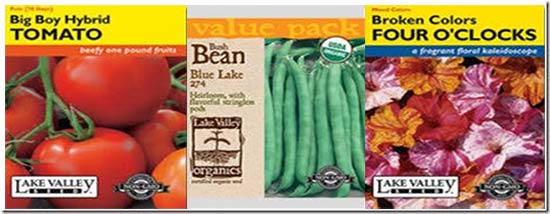Economize: Start Your Own Plants From Seed
Many types of vegetable and flower seeds may be started early indoors to get a head start on the spring growing season. The controlled conditions we can provide indoors are a safe place for seeds to sprout and grow into sturdy, young plants before having to face the rigors of unpredictable weather conditions outdoors
To determine just how early to sow various seeds indoors, check the seed packets. Different seeds sprout and grow at different rates so you will need to determine how much time will be necessary for the seedlings to reach the desired size before placing outdoors. Most flowers and vegetables should not be planted outside until mid-May, after the danger of frost has passed.
GROWING CONTAINERS
There are two main procedures used to start seeds. One is sowing the seeds in rows in a large open tray, then transplanting the seedlings into individual peat pots when they are large enough. Or seeds may be sown directly into the individual peat pots and allowed to develop without disturbance, however, this method requires a great deal more space over a longer period of time.
POTTING SOIL/MIXES
It is important to use only sterilized seed starting mixes. Soil from outside should never be used as it can contain fungus, causing 'damping-off', which will kill your seedlings. Some gardeners prefer a 'soilless' mix of perlite or vermiculite, these retain more moisture and require less watering.
SOWING, WATERING AND TEMPERATURES
Read the seed packet for special instructions, some seeds need to be soaked overnight or require prechilling.
Before planting your seeds in the growing mix, moisten the mix with warm water. Once the mix is thoroughly moist, sow the seeds. Use at least 3 seeds per container. Cover the seeds lightly with soil, then gently mist the top of the soil. Mist whenever the soil begins to dry slightly; avoid heavy drenchings that may disturb the seeds.
LABEL the pots with markers…YOU WILL NOT REMEMBER which seeds are in which pots!
Finally, place plastic wrap over the trays or pots to keep humidity high and to trap warmth.
Place pots in a bright window, direct sun is best. If you do not have a bright window you will need to provide a fluorescent light. Place the light 6 inches above the seed trays/pots and keep the light on 12 hours a day. Most seeds will germinate at temperatures of 70-75 degrees F. If your home is not warm enough, you may use a heating cable or mat to provide more heat. You should see the first signs of germination in a few days.
TRANSPLANTING
Once the little seedlings have emerged, remove the plastic cover and move the trays/pots into Indirect light. Be sure potting mix stays moist but NOT wet. When the first true leaves have developed (usually the second pair of leaves), transplant them to individual peat pots for several more weeks. Use 3-4" pots to allow room for root development. Use a balanced fertilizer high in nitrogen and potassium to encourage good roots and healthy growth. Seedlings can remain in these pots until you are ready to plant them in their permanent spots.
If more than one seedling is growing in the same pot, either separate them into individual pots or cut off all but the strongest seedling. DO NOT PULL out the extra seedling, this might harm the roots of the seedling you are keeping.

We have all of the supplies you need for successful seed starting and growing.
WE CARRY ORGANIC AND NON GMO SEEDS
PLACING SEEDLINGS OUTDOORS
Before placing your young plants in their outdoor beds it is necessary to prepare them. This is known as "Hardening off" and gives the plants a chance to acclimate to sunlight, drying winds and temperature changes. Seedlings will wither quickly if planted directly outdoors. Prepare them by placing the trays/pots in a shady protected site for a few hours daily, bringing them inside at night. Over a 1-2 week period, gradually subject them to increased amounts of sun and eventually leave them outside overnight
After this time, they may be planted outdoors, after the danger of frost has passed. Plant in loose, well-drained soil…we recommend BUMPER CROP brand of potting soils…water them thoroughly after transplanting, and if possible, move them on an overcast day.
DON'T FORGET to water and fertilize on a regular basis along with your established plants.
HAPPY GROWING!

